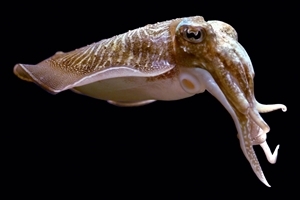Common cuttlefish
 It’s an animal that can change colour, has eight sucker-covered arms growing out of its head, three hearts pumping its blue-green hemocyanin blood, and a doughnut-shaped brain.
It’s an animal that can change colour, has eight sucker-covered arms growing out of its head, three hearts pumping its blue-green hemocyanin blood, and a doughnut-shaped brain.
By this brief description, you would think this species was from the Netflix series Stranger Things, but in fact, this species which is a resident of our shores – the common cuttlefish (Sepia officinalis), also known as the European cuttlefish.
I realised while I was away over the weekend in Dorset that February had crept up on me fast and I had not had much time to think of what species to write about, but while I was walking along the coast path that runs along Lulworth Cove, I spotted a cuttlefish bone on the beach and thought this would be a good one to investigate.
Cuttlefish are not fish, but cephalopods (a predatory mollusc related to octopus and squid) and dwell in deep water (100-200m) in the winter and move into shallower coastal waters to breed in the spring on sandy or muddy substrates in coastal and marine water, generally found in the eastern North Atlantic, throughout the English Channel. Records exist along the east coast of Britain, the west and north coast of Scotland, including the Hebrides, but these are not as common as in the English Channel.
The common cuttlefish is the largest British cuttlefish weighing 2-4kg, and like other cephalopods, has sophisticated eyes located on either side of its broad head. Although they cannot see colour, they can perceive the polarization of light, which enhances their perception of contrast. The eyes have unusual smoothly curving W-shaped pupils and can even see backwards! Cuttlefish are highly intelligent and have one of the largest brains of any invertebrate. This, and their well-developed nervous system, have proven that cuttlefish are neurologically advanced. The cuttlefish brain can process input from senses like sight, smell, and even ‘sound’ in the form of pressure waves.
They have eight arms (two elongated tentacles), which are kept tucked away in pouches by the side of the head when the cuttlefish are not using them to catch prey, and a mantle (a hood made of muscle and skin that covers the body), which is 25-30cm long in females, reaching up to 45cm in males. They have a pair of flat, wide fins (like a skirt) that encompasses their entire mantle, but when looking closely at the tail of the cuttlefish it will reveal that these are two separate fins, which do not meet. Within their bodies, cuttlefish have an oval internal shell, the cuttlebone. The cuttlebone is used to regulate buoyancy, using chambers that may be filled with gas and/or water, which when dead can often be found washed up on shore or seen in budgie cages!
They are not very sociable, but are active predators feeding on molluscs, fish, and crabs and have a ‘beak-like’ jaw in the middle of their arms used to break open shells. I have had the pleasure of watching them hunt while snorkelling off the Dorset coast – it was fascinating!
Cuttlefish are relatively short lived, living from 1-2 years and sometimes referred to as the ‘chameleons of the sea’ due to their colour-changing abilities to match their surroundings, escape the attention of predators, or in the case of males, to attract mates. They do this by using the pigment cells in their skin, called chromatophores. Colours of cuttlefish include yellow, red, orange, black or brown. These cells can be used independently or together to produce different colours and patterns, which can also flash. Like octopus, cuttlefish have an ink sac from which they can expel ink (called sepia), when in danger, or to confuse an enemy.
Mating for the common cuttlefish involves internal fertilisation. The male deposits sperm into the female’s buccal membrane (close to the mouth). The female generally lays eggs (between 150 and 1,000) in spring, at depths around 30 or 40 m and attaches them as clusters to various plants, or dead structures such as drowned trees, cables, crab pots or nets. The length of embryonic development is temperature dependent.
Like squid species, the common cuttlefish is valuable commercially, and as a non-quota species large numbers can be taken by British fishermen, leading to concern over long-term numbers, although the International Union for the Conservation of Nature currently classes this species as one of Least Concern. They can be seen in spring and summer in shallow waters when the cuttlefish migrate to warmer waters to breed.
Megan Lock
Advisory
Image credit: Hans Hillewaert